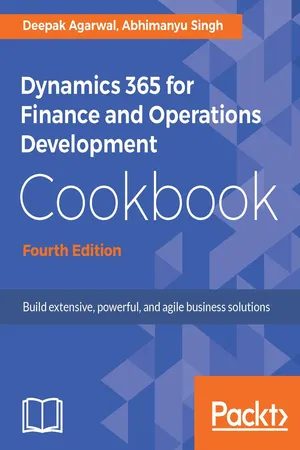
Dynamics 365 for Finance and Operations Development Cookbook - Fourth Edition
Deepak Agarwal, Abhimanyu Singh
- 480 pagine
- English
- ePUB (disponibile sull'app)
- Disponibile su iOS e Android
Dynamics 365 for Finance and Operations Development Cookbook - Fourth Edition
Deepak Agarwal, Abhimanyu Singh
Informazioni sul libro
Over 80 effective recipes to help you solve real-world Microsoft Dynamics 365 for Finance and Operations development problemsAbout This Book• Learn all about the enhanced functionalities of Dynamics 365 for Finance and Operations and master development best practices• Develop powerful projects using new tools and features• Work through easy-to-understand recipes with step-by-step instructions and useful screenshotsWho This Book Is ForIf you are a Dynamics AX developer primarily focused on delivering time-proven applications, then this book is for you. This book is also ideal for people who want to raise their programming skills above the beginner level, and at the same time learn the functional aspects of Dynamics 365 for Finance and Operations. Some X++ coding experience is expected.What You Will Learn• Explore data manipulation concepts in Dynamics 365 for Operations• Build scripts to assist data migration processes• Organize data in Dynamics 365 for Operations forms• Make custom lookups using AOT forms and dynamically generate them from X++ code• Create a custom electronic payment format and process a vendor payment using it• Integrate your application with Microsoft Office Suite and other external systems using various approaches• Export and import business data for further distribution or analysis• Improve your development efficiency and performanceIn DetailMicrosoft Dynamics 365 for Finance and Operations has a lot to offer developers. It allows them to customize and tailor their implementations to meet their organization's needs. This Development Cookbook will help you manage your company or customer ERP information and operations efficiently. We start off by exploring the concept of data manipulation in Dynamics 365 for Operations. This will also help you build scripts to assist data migration, and show you how to organize data in forms. You will learn how to create custom lookups using Application Object Tree forms and generate them dynamically.We will also show you how you can enhance your application by using advanced form controls, and integrate your system with other external systems. We will help you script and enhance your user interface using UI elements. This book will help you look at application development from a business process perspective, and develop enhanced ERP solutions by learning and implementing the best practices and techniques.Style and approachThe book follows a practical recipe-based approach, focusing on real-world scenarios and giving you all the information you need to build a strong Dynamics 365 for Finance and Operations implementation.
Domande frequenti
Informazioni
Working with Data in Forms
- Using a number sequence handler
- Creating a custom filter control
- Creating a custom instant search filter
- Building a selected/available list
- Creating a wizard
- Processing multiple records
- Coloring records
- Adding an image to records
Introduction
Using a number sequence handler
How to do it...
- Create a new project, UsingNumberSeqhandler, create a new extension class CustGroup_Extension for the CustGroup form, and add the following code snippet to its class declaration:
public NumberSeqFormHandler numberSeqFormHandler;
- Also, create a new method called numberSeqFormHandler() in the same class:
public NumberSeqFormHandler numberSeqFormHandler() { if (!numberSeqFormHandler) { numberSeqFormHandler = NumberSeqFormHandler::newForm(
CustParameters::numRefCustGroupId().NumberSequenceId,
this,this.CustGroup_ds,fieldNum(CustGroup,CustGroup));
} return numberSeqFormHandler; } - To override the CustGroup data source's create() method, copy the OnCreating and OnCreated events from the data source and paste them in the class CustGroup_Extension with the following code snippet:
[FormDataSourceEventHandler(formDataSourceStr(CustGroup,
CustGroup), FormDataSourceEventType::Creating)] public void CustGroup_OnCreating(FormDataSource sender,
FormDataSourceEventArgs e) { this.numberSeqFormHandler().formMethodDataSourceCreatePre(); } [FormDataSourceEventHandler(formDataSourceStr(CustGroup,
CustGroup), FormDataSourceEventType::Created)] public void CustGroup_OnCreated(FormDataSource sender,
FormDataSourceEventArgs e) { this.numberSeqFormHandler().formMethodDataSourceCreate(); }
- Then, to override its delete() method, subscribe to the OnDeleting event of the CustGroup data source and paste it in the extension class with the following code snippet:
[FormDataSourceEventHandler(formDataSourceStr(CustGroup,
CustGroup), FormDataSourceEventType::Deleting)] public void CustGroup_OnDeleting(FormDataSource sender,
FormDataSourceEventArgs e) { this.numberSeqFormHandler().formMethodDataSourceDelete(); }
- Then, to override the data source's write() method, subscribe to the OnWritten event with the following code snippet:
[FormDataSourceEventHandler(formDataSourceStr(CustGroup,
CustGroup), FormDataSourceEventType::Written)] public void CustGroup_OnWritten(FormDataSource sender,
FormDataSourceEventArgs e) { this.numberSeqFormHandler().formMethodDataSourceWrite(); }
- Similarly, to override its validateWrite() method, subscribe to the OnValidatedWrite event of the CustGroup data source with the following code snippet:
[FormDataSou...